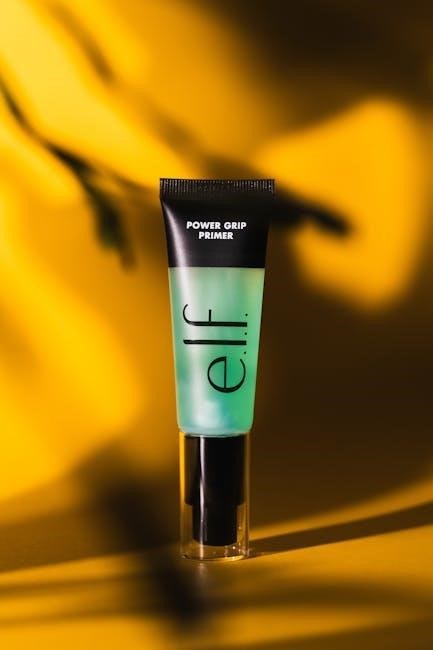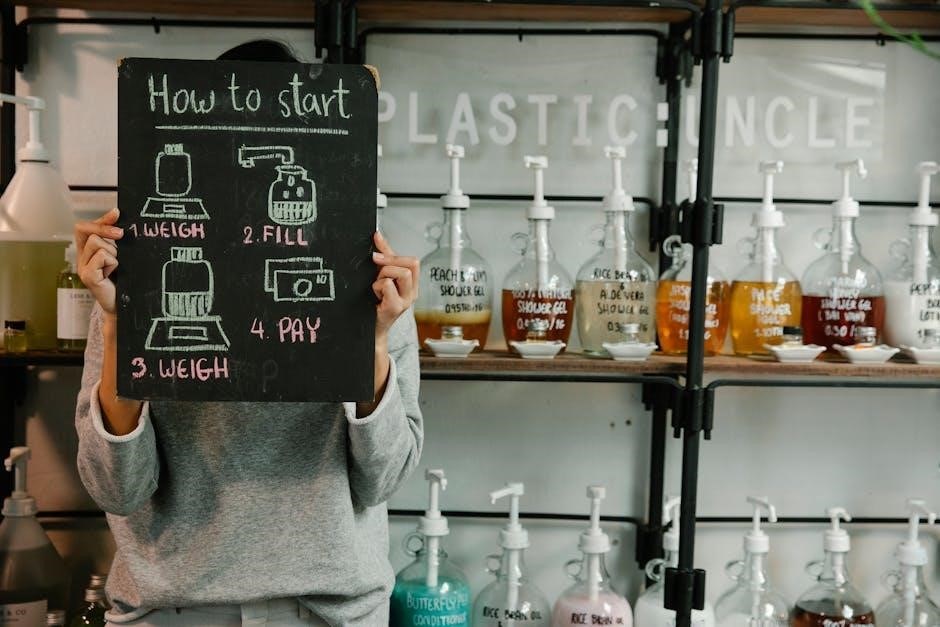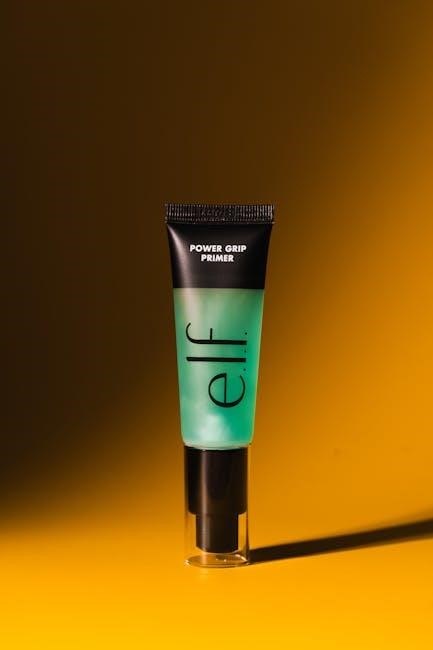Zinsser Bulls Eye 1-2-3 primer is a versatile‚ water-based primer-sealer suitable for both interior and exterior surfaces. It’s known for its excellent adhesion‚ even on glossy surfaces like enamel paints‚ Formica‚ and ceramic tile‚ without requiring sanding beforehand to improve paint adhesion to the surface.

Overview of Zinsser Bulls Eye 1-2-3 Primer
Zinsser Bulls Eye 1-2-3 is a water-based primer-sealer renowned for its versatility and strong adhesion properties. This primer is designed for both interior and exterior applications‚ making it a go-to choice for a wide array of projects. Its ability to bond to various surfaces without sanding sets it apart‚ saving time and effort during surface preparation. It effectively seals porous surfaces.
One of the key features of Bulls Eye 1-2-3 is its low odor‚ which makes it more pleasant to work with‚ especially in enclosed spaces. The quick-drying formula allows for faster project completion‚ while its mold and mildew-resistant film makes it suitable for high-humidity areas such as bathrooms and kitchens. It’s also effective at sealing stains‚ graffiti‚ and tannin bleed‚ ensuring a clean and uniform surface for topcoats.
This primer is compatible with a variety of topcoats‚ including latex and oil-based paints. It’s an all-purpose primer suitable for residential‚ commercial‚ and industrial applications. Whether you’re painting walls‚ ceilings‚ doors‚ or trim‚ Zinsser Bulls Eye 1-2-3 provides a reliable foundation for a professional-looking finish. Always ensure proper ventilation during application.
Suitable Surfaces for Application
Zinsser Bulls Eye 1-2-3 primer is formulated for use on a wide range of interior and exterior surfaces‚ offering excellent adhesion and sealing properties. This versatility makes it a popular choice for various painting projects. Interior applications include walls‚ ceilings‚ doors‚ trim‚ and related paintable surfaces. It adheres well to drywall‚ plaster‚ wood‚ and even previously painted surfaces.
Exterior applications are equally diverse‚ encompassing surfaces such as siding‚ fascia‚ soffits‚ foundations‚ and railings. Bulls Eye 1-2-3 can be applied to wood‚ metal‚ and concrete‚ providing a solid base for topcoats. Its ability to bond to hard-to-stick surfaces without sanding makes it suitable for glossy enamel paints‚ clear finishes‚ Formica‚ PVC‚ fiberglass‚ vinyl‚ and ceramic tile.
This primer is also effective on surfaces prone to stains and mildew‚ such as those found in kitchens and bathrooms. Its mold and mildew-resistant properties help protect the substrate from damage and ensure a long-lasting finish. Bulls Eye 1-2-3 is designed to handle a variety of environments and surface conditions‚ making it a reliable choice for both residential and commercial projects. Always consult specific project needs.
Surface Preparation Before Priming
Proper surface preparation is crucial for ensuring optimal adhesion and performance of Zinsser Bulls Eye 1-2-3 primer. Start by thoroughly cleaning the surface to remove any dirt‚ dust‚ grease‚ oil‚ wax‚ or other contaminants. Use a suitable cleaner and rinse well with water‚ allowing the surface to dry completely before proceeding.
Inspect the surface for any loose‚ peeling‚ or unsound coatings. Remove these materials by scraping‚ sanding‚ or using a wire brush. Feather the edges of any remaining paint film to create a smooth transition. For bare aluminum‚ scuff sand the surface to promote better adhesion. Address any existing mold or mildew by treating the affected areas with a mildewcide solution‚ following the manufacturer’s instructions carefully.
Spot prime knots and sap streaks with Zinsser B-I-N Primer before applying Bulls Eye 1-2-3 to the entire surface. This will help to prevent tannin bleed and ensure a uniform finish. Fill any holes or cracks with appropriate patching compound and sand smooth. Ensure all repairs are fully dry before applying the primer. Taking the time to properly prepare the surface will result in a more professional and long-lasting paint job.
Application Methods
Zinsser Bulls Eye 1-2-3 primer can be applied using various methods‚ including brushes‚ rollers‚ and spray equipment‚ depending on the project’s size‚ complexity‚ and desired finish. When using a brush‚ choose a high-quality synthetic bristle brush for smooth and even application‚ especially on trim and detailed areas. For larger surfaces like walls and ceilings‚ a roller with a suitable nap length is recommended to ensure adequate coverage and minimize brush marks.
For spray application‚ whether using an airless or conventional sprayer‚ follow the manufacturer’s instructions for thinning and spray settings. Ensure proper ventilation and wear appropriate respiratory protection when spraying. Apply the primer in thin‚ even coats‚ overlapping each pass slightly to avoid streaks or runs. Maintain a consistent distance and angle from the surface for uniform coverage.
Regardless of the application method‚ avoid applying the primer too thickly‚ as this can lead to drips‚ runs‚ and extended drying times. In most cases‚ only one coat is necessary to provide adequate sealing and adhesion. However‚ porous surfaces may require a second coat for proper sealing. Allow the primer to dry completely between coats‚ following the recommended drying times specified on the product label.
Thinning and Cleanup
Zinsser Bulls Eye 1-2-3 primer is typically ready to use straight from the can and does not require thinning for most applications. However‚ thinning may be necessary when using spray equipment to achieve the desired consistency and flow. If thinning is required‚ consult the product label for specific recommendations on the appropriate thinning agent and ratios. Over-thinning can compromise the primer’s performance‚ so it’s essential to follow the manufacturer’s guidelines carefully.
Cleanup of Zinsser Bulls Eye 1-2-3 primer is relatively easy due to its water-based formulation. For brushes and rollers‚ remove excess primer and rinse thoroughly with warm‚ soapy water. Repeat until all traces of primer are gone. For spray equipment‚ flush the system with clean water according to the manufacturer’s instructions. It’s crucial to clean tools and equipment promptly after use to prevent the primer from drying and hardening‚ which can make cleanup more difficult.
Proper disposal of leftover primer and cleaning materials is essential for environmental responsibility. Do not pour leftover primer down the drain. Instead‚ allow it to dry completely in the can and dispose of it according to local regulations. Similarly‚ dispose of used cleaning water and rags properly. By following these thinning and cleanup guidelines‚ you can ensure optimal performance and longevity of your application tools.
Drying Time Considerations
Drying time is a crucial factor to consider when working with Zinsser Bulls Eye 1-2-3 primer to ensure proper adhesion and performance of subsequent coats. Generally‚ this primer offers quick drying convenience‚ but the actual drying time can vary depending on several factors. These include ambient temperature‚ humidity levels‚ and the thickness of the applied coat. Warmer temperatures and lower humidity levels will typically result in faster drying times‚ while cooler temperatures and higher humidity can prolong the drying process.
As a general guideline‚ Zinsser Bulls Eye 1-2-3 primer usually dries to the touch within 1 hour. However‚ it’s essential to allow sufficient time for the primer to fully cure before applying the topcoat. The recommended recoat time is typically around 1 to 2 hours under normal conditions; Allowing the primer to cure adequately ensures that it forms a strong bond with the surface and provides a stable base for the topcoat.

For optimal results‚ it’s advisable to check the product label for specific drying time recommendations and to test a small‚ inconspicuous area before proceeding with the entire project. If the drying conditions are less than ideal‚ it may be necessary to extend the drying time to ensure proper curing and adhesion. Rushing the drying process can lead to problems such as blistering‚ peeling‚ or poor adhesion of the topcoat.
Coverage Area
Understanding the coverage area of Zinsser Bulls Eye 1-2-3 primer is essential for accurately estimating the amount of product needed for a project‚ minimizing waste‚ and ensuring adequate priming of the surface. The typical coverage area for this primer is approximately 300 to 400 square feet per gallon. However‚ practical coverage can vary depending on several factors‚ including the porosity and texture of the substrate.
Porous surfaces‚ such as bare wood or unpainted drywall‚ will absorb more primer‚ resulting in a lower coverage area. Conversely‚ smoother‚ non-porous surfaces will require less primer‚ leading to a higher coverage area. The application method also plays a role in determining coverage. Spraying the primer may result in slightly lower coverage due to material losses‚ while applying it with a brush or roller can provide more precise coverage.
To accurately estimate the amount of primer needed‚ it’s crucial to measure the surface area to be primed and consider the substrate’s porosity. For porous surfaces‚ it’s advisable to assume a lower coverage rate‚ while for non-porous surfaces‚ a higher coverage rate can be used. Always err on the side of caution and purchase slightly more primer than estimated to avoid running out mid-project. Remember that certain applications might need a second coat.
Dealing with Stains and Odors

Zinsser Bulls Eye 1-2-3 primer is effective at sealing many common household stains and odors‚ making it a valuable tool for preparing surfaces for painting. It can block stains caused by water‚ nicotine‚ smoke‚ tannin‚ pencil‚ ink‚ grease‚ and felt marker. Additionally‚ it seals in odors from smoke and pets‚ creating a fresh‚ clean surface for topcoating.
For light to moderate stains and odors‚ one coat of Zinsser Bulls Eye 1-2-3 primer may be sufficient. However‚ severe stains or persistent odors may require a second coat for optimal results. In cases of extreme staining or odor issues‚ consider using Zinsser B-I-N primer‚ a shellac-based primer specifically designed for heavy-duty stain and odor blocking. Before applying any primer‚ it’s essential to clean the surface thoroughly to remove any loose debris or residue that could interfere with adhesion.
Spot prime knots and sap streaks with Zinsser B-I-N primer before priming the full surface with Bulls Eye 1-2-3 for best results on wood surfaces with potential bleed-through. Allow the primer to dry completely according to the manufacturer’s instructions before applying the topcoat. This will ensure that the stains and odors are effectively sealed‚ preventing them from bleeding through the finished paint.

When to Apply a Second Coat
While Zinsser Bulls Eye 1-2-3 primer typically provides adequate coverage and sealing with a single coat‚ certain situations warrant the application of a second coat to ensure optimal results. The need for a second coat primarily depends on the porosity of the surface‚ the severity of existing stains or odors‚ and the desired level of finish.
Highly porous surfaces‚ such as bare wood or unsealed drywall‚ tend to absorb more primer‚ potentially leaving some areas insufficiently sealed. In such cases‚ a second coat will ensure uniform coverage and prevent the topcoat from being absorbed unevenly‚ leading to a blotchy appearance. Similarly‚ if the surface has noticeable stains from water damage‚ smoke‚ or other sources‚ a second coat of primer can help to block these stains from bleeding through the topcoat.
Furthermore‚ a second coat of primer can enhance the adhesion of the topcoat‚ especially on glossy or non-porous surfaces. Before applying a second coat‚ allow the first coat to dry completely according to the manufacturer’s instructions; Inspect the primed surface for any imperfections or areas that may require additional attention. Lightly sand any rough spots before applying the second coat to ensure a smooth and even finish.
